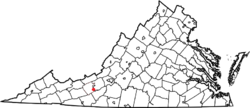Snowville, Virginia
| Snowville, Virginia | |
|---|---|
| Census-designated place (CDP) | |

The community of Snowville along the Little River
|
|
 Location of Snowville, Virginia |
|
| Coordinates: 37°1′57″N 80°33′40″W / 37.03250°N 80.56111°WCoordinates: 37°1′57″N 80°33′40″W / 37.03250°N 80.56111°W | |
| Country | United States |
| State | Virginia |
| County | Pulaski |
| Elevation | 1,940 ft (591 m) |
| Population (2010) | |
| • Total | 149 |
| • Density | 66.2/sq mi (5.9/km2) |
| Time zone | Eastern (EST) (UTC-5) |
| • Summer (DST) | EDT (UTC-4) |
| ZIP code | 24347 |
| Area code(s) | 540 |
Snowville is a census-designated place (CDP) located in southeastern Pulaski County in the Commonwealth of Virginia. The population, as of the 2010 Census, was 149. It is part of the Blacksburg–Christiansburg–Radford Metropolitan Statistical Area.
Snowville is located at 37° 1' 57"N, 80° 33' 40"W (37.032500°, -80.561111°). The community lies along the Little River, which forms the boundary between Pulaski County on the west side and Montgomery County on the east. Snowville lies within the Blue Ridge Mountains, part of the Appalachian Mountain Range, with High Knoll Mountain and Bench Mountain marking the southern extent of the community. It is bounded to the north by Claytor Lake.
Snowville and Pulaski County are located in a temperate climatic zone, with average winter temperatures in the 30s and 40s (degrees Fahrenheit) and summer temperatures in the 70s and 80s. Average winter snowfall amounts range from 12 to 24 inches (300 to 610 mm). During spring, flash flooding can occur with runoff from nearby mountains, and during fall tropical storms can bring heavy amounts of rainfall and damaging winds, such as during Hurricane Hugo in 1989. Research has been undertaken at Virginia Tech and at the National Weather Service office in Blacksburg to examine the potential for flash flooding along creeks, streams, and rivers in Pulaski County using geographic information systems (GIS) and field methods. Extreme heat and drought are rare, but have occurred, as have very cold temperatures below 0° Fahrenheit.
...
Wikipedia
